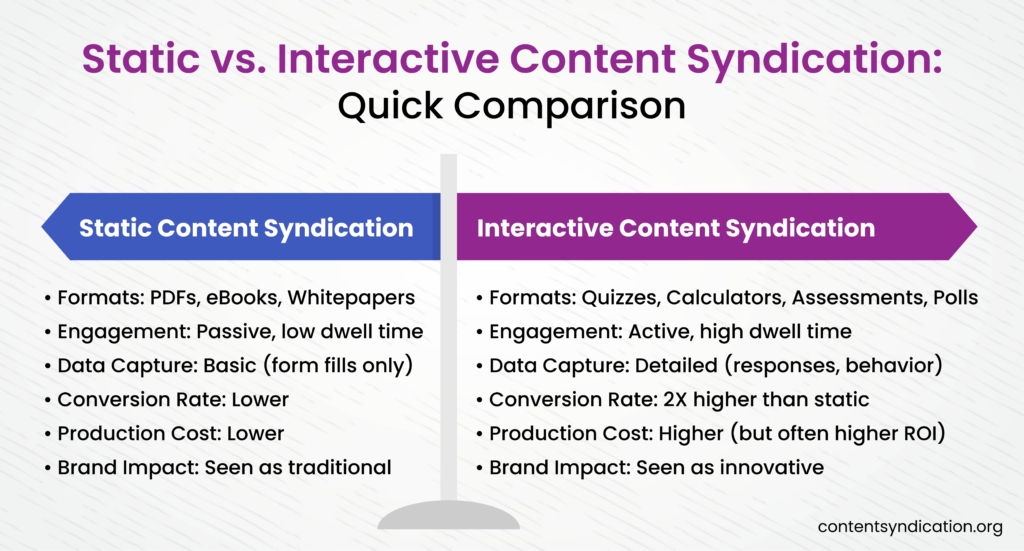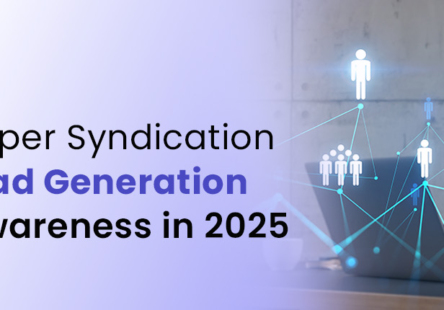Content syndication has long been a core part of the B2B marketing playbook. Traditionally, this meant static formats like whitepapers, PDFs, and eBooks. But as digital behavior evolves, static content no longer fits the picture.
Today’s buyers expect experiences, not just information. This is why interactive content syndication, such as quizzes, assessments, calculators, polls, and interactive infographics, is gaining momentum.
The goal is clear: a shift from passive consumption to active engagement. Yet many marketers hesitate, thinking it is too costly. But this blog will surely change this notion, and you will rethink the possibilities.
Before moving to interactive content syndication, let’s throw light on the existing static content framework. This way, you will know why interactive content is no longer optional but an urgent shift you need to make.
Static Content Syndication Works for Reach but Lacks Depth

Static syndication remains popular for obvious reasons: it is quick to produce, cost-effective, and reliable for evergreen topics that do not require frequent updates.
But the limitations are equally obvious:
- Download forms usually capture little more than an email address.
- Readers rarely finish a PDF.
- Leads often fail to convert.
Many teams still waste time and effort by equating download volume with lead quality, which creates more frustration for sales than opportunities.
Interactive Content Syndication Engages Audiences and Captures Intent
Interactive syndication feels less like a lecture and more like a coffee shop experience. With this experience, audiences are not passively skimming, they click, respond, and explore.
But doing interactivity for the sake of it will not help. For instance, having a calculator with outdated benchmarks or a quiz with irrelevant questions erodes trust. This means interactive assets require ongoing updates.
And those investing in iteration will surely reap the benefits of richer insights, stronger buyer intent, and differentiation.
And no wonder 88% of marketers believe interactive content helps them stand out from competitors.
So, it is not just another tactic. It is an innovative approach that aligns with changing audiences and positions brands as customer-first.
When Interactive Syndication Creates the Most Impact
Does every campaign demand interactivity? Not necessarily. It shines in situations where static formats fall short. It becomes essential when:
- Lead quality is weak and marketers need richer behavioral data to qualify prospects.
- Long sales cycles slow decision-making and buyers need tools like ROI calculators or assessments to move forward.
- Audiences are digitally savvy and disengaged with traditional PDFs and reports.
- Markets are saturated and brands must differentiate themselves with innovation and unique experiences.
These scenarios show why interactivity is more than a top-of-funnel tactic. By capturing intent data and guiding prospects through self-discovery, it drives education and accelerates decisions across the funnel.
With 93% of marketers confirming interactive content is highly effective for educating buyers, it is no longer optional but increasingly expected.
Balancing Costs with Returns in Interactive Syndication
Cost is often the reason marketers hesitate. Interactive experiences require design, technology, and ongoing support. And yes, it can feel overwhelming compared to the ease of static production.
But treating costs as sunk rather than strategic investment is a misconception. The returns prove otherwise. Outgrow reports that interactive content delivers 52.6% higher engagement compared to static assets.
That engagement translates into better lead quality, more precise nurturing, and conversions that are up to twice as strong.
When considering both sales efficiency and pipeline velocity, the value often outweighs the expense.
To evaluate the balance clearly, consider:
- Cost Drivers: design and development, technology platforms, maintenance, and syndication fees.
- Returns: stronger engagement, higher conversion rates, richer insights for segmentation, and better long-term pipeline health.
The best approach is to test before scaling. To get started, pilot one interactive asset such as a calculator or diagnostic quiz.
This provides benchmarks against static performance and reveals whether the impact justifies expansion.
How to Transition from Static to Interactive Syndication Step by Step
Making the switch does not mean abandoning static content. Instead, it is about layering interactive formats on top of proven assets to capture deeper engagement.
Static content remains valuable for awareness and SEO, while interactive formats add precision and intent signals.
The transition works best when marketers follow a structured process:
- Audit existing static assets and identify top performers to reimagine.
- Define clear goals such as higher engagement, better lead quality, or faster pipeline progression.
- Pilot with one or two syndication partners and measure results against static campaigns.
- Iterate and scale once ROI is proven.
This way, marketers minimize risk, refine user experiences, and build a business case for scaling. Keeping a blend of static and interactive ensures continuity while evolving toward richer engagement.
Conclusion – Choosing the Right Syndication Mix for Your Goals
Static syndication still matters. It is affordable, reliable, and effective for reach and evergreen visibility.
But if you want to achieve a competitive edge, interactive syndication is essential. It solves pain points that static cannot: low lead quality, limited engagement, and lack of differentiation.
The smartest marketers no longer ask whether to choose one or the other. Instead, they align formats with goals.
- For awareness and reach, static is often enough.
- For greater impact like engagement, lead quality, and differentiation, interactive syndication is the stronger choice.
As Jonathan Midenhall, former CMO of Airbnb, once said:
“Amazing things will happen when you listen to the consumer.”
Interactive syndication embodies this philosophy. It is about creating meaningful conversations, not just distributing content.
Brands that embrace it will build stronger connections, win more attention, and generate better results in an increasingly crowded marketplace.
Frequently Asked Questions (FAQ)
What is interactive content syndication?
Interactive content syndication distributes engaging formats like quizzes, calculators, and assessments to capture intent and generate qualified leads.
How is interactive content syndication different from static?
Static uses PDFs/eBooks with low engagement, while interactive uses tools that double engagement and deliver richer lead data.
Why is interactive syndication important for B2B lead generation?
It captures detailed insights, improves targeting, and typically delivers 2X conversion rates compared to static.
When should marketers use interactive syndication?
It works best in ABM campaigns, mid-funnel nurturing, and when high-quality MQLs are the goal.




